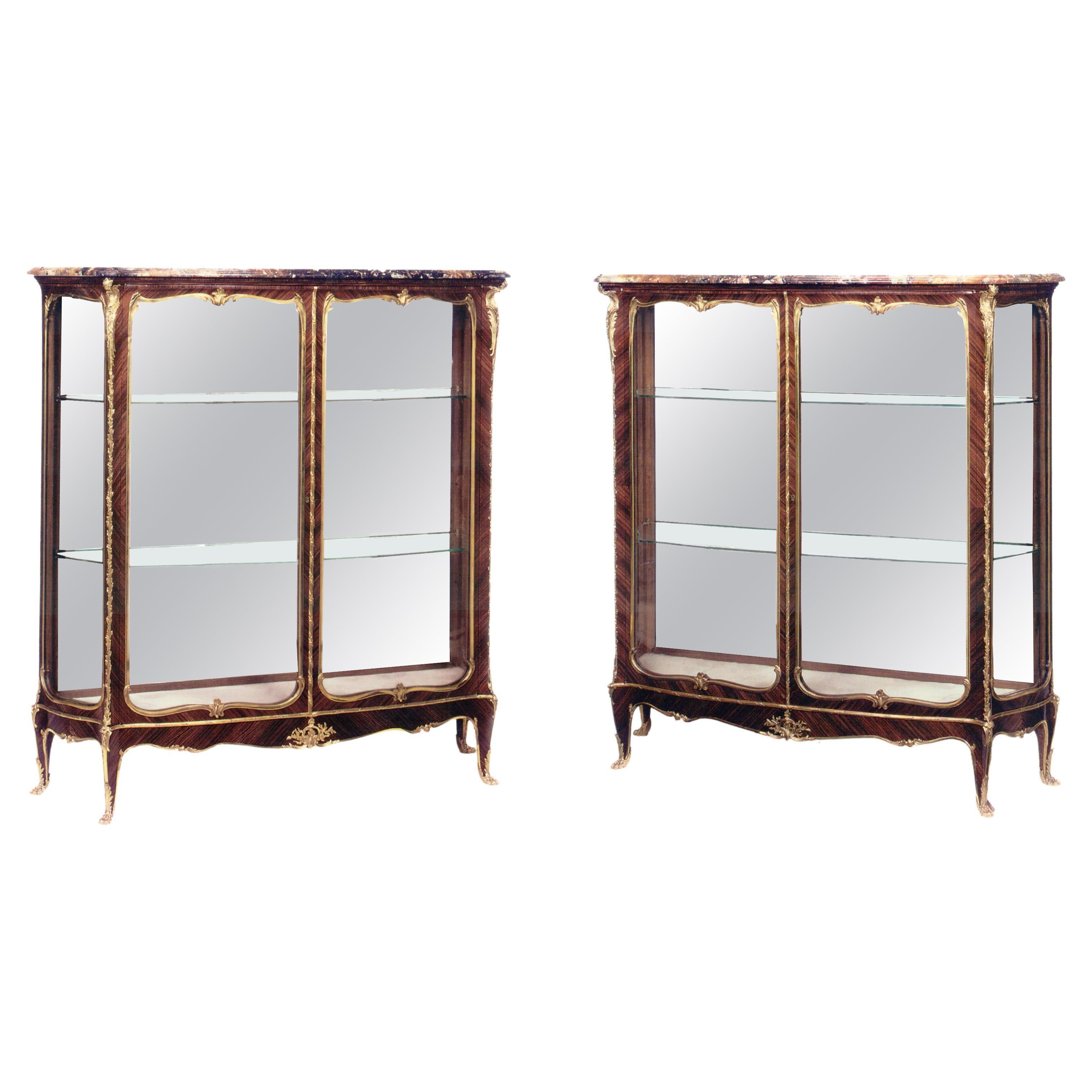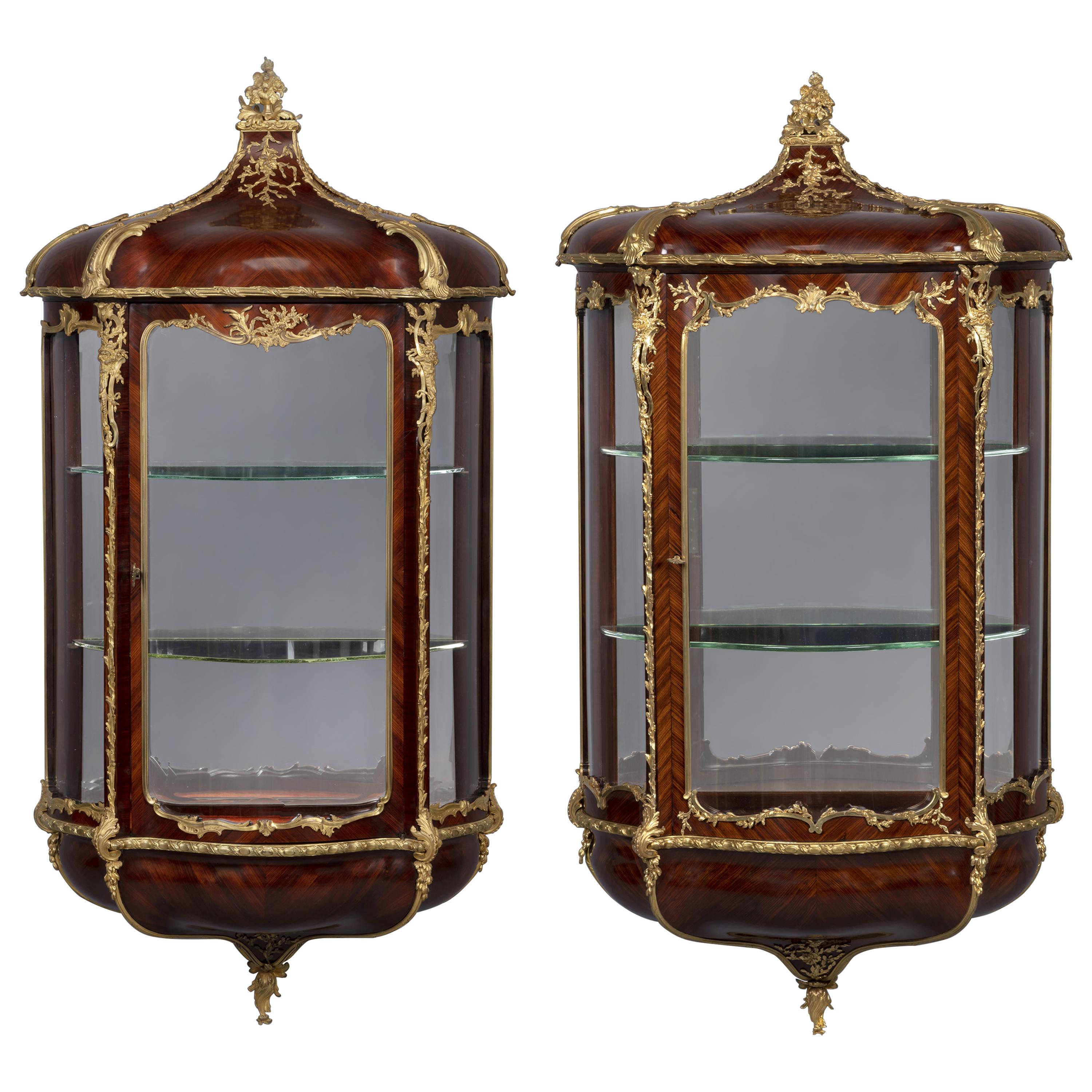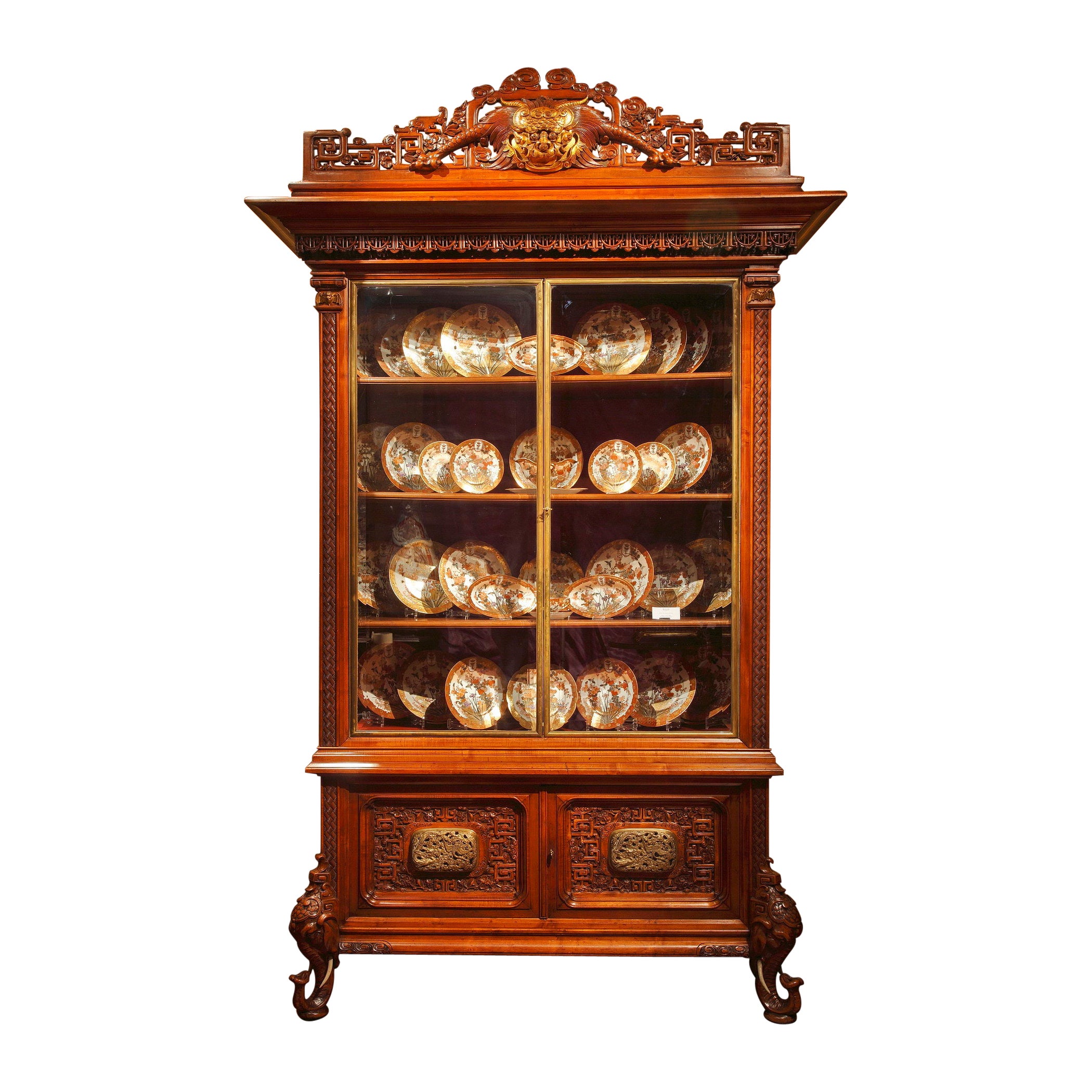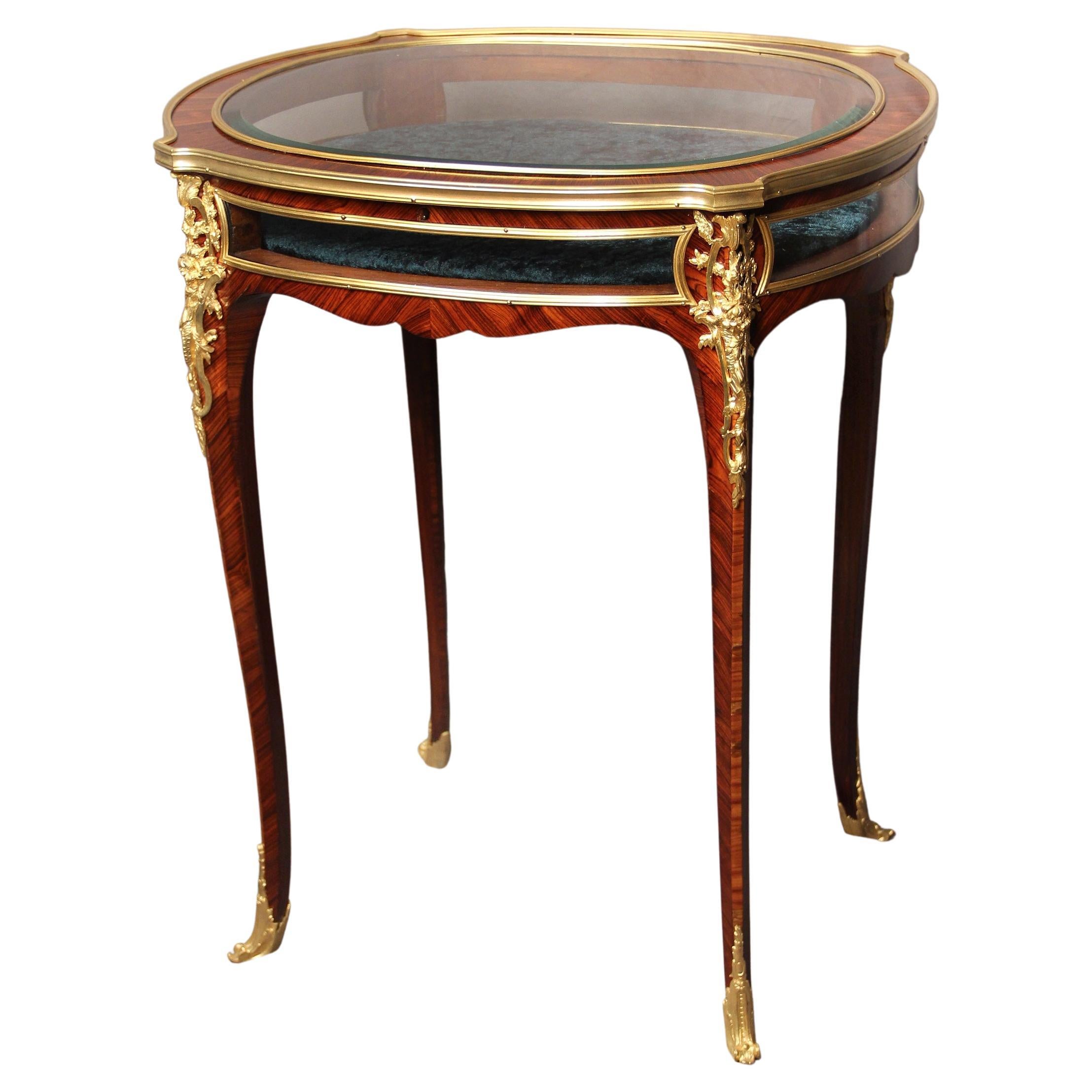Items Similar to Vitrine Attributed to J.E. Zwiener and L. Messagé, France, Circa 1890
Want more images or videos?
Request additional images or videos from the seller
1 of 8
Vitrine Attributed to J.E. Zwiener and L. Messagé, France, Circa 1890
About the Item
Elegant vitrine in veneered wood and gilded bronze. Opening with two curved doors with foliated frame in gilded and chiseled bronze, it is composed in the upper part of bevelled glass and in the lower part of « end-cut » floral inlays. Resting on four curved feet ending with lion paws, the whole is covered with a molded « Vert de mer » marble top. The work on this vitrine is characteristic of Zwiener’s workshops for its quality and finesse and of L. Messagé for the design.
Joseph-Emmanuel Zwiener was born in Germany in 1849. In 1880 he sets up his extensive workshops in rue de la Roquette in Paris where he creates many original pieces of furniture. He imitated practically every style, ranging from ‘’Boulle’’ to Louis XVI and including extraordinary personal interpretations of the Louis XV ‘’exuberant’’ style. He participated in the 1889 Universal Exhibition, held in Paris, and was awarded the Gold Medal for his remarkable copy of that most famous piece of furniture, Louis XV’s desk. The catalogue of the exhibition included a wonderful elegy qualifying the work as perfect: « No criticism what-so-ever could be made ». As that other famous cabinet-maker François Linke, Zwiener had most of his bronzes modelled by Léon Messagé whose work was considered as being of the best possible quality.
Léon Messagé is a renowned designer and sculptor who integrated in his ornaments related to the Rocaille asymmetry, new lines and shapes announcing the “Art Nouveau” style. But even though, Messagé found inspiration with these 18th century artists, such as Nicolas Pineau or J. A. Meissonier, he didn’t simply copy their work and showed great originality, even extravagance, with some designs contained in "Cahier des dessins et croquis style Louis XV". He realized numerous sketches on grey paper before the execution of a reduced or life-sized model of his ornaments, made of wax or terracotta. From 1885, Léon Messagé started working with important Parisian cabinet-makers such Joseph-Emmanuel Zwiener (1849-1895) and François Linke (1855-1946). François Linke developed his personal style, with such talent and quality that he was named during the 1900 Universal Exhibition the "Linke Style". His tremendous success and his particular formal imagination came from his association with the designer Léon Messagé. The mutual influences concerning these three artists can be concretely observed in numerous realizations.
- Attributed to:Joseph-Emmanuel Zwiener (Cabinetmaker)Léon Messagé (Designer)
- Dimensions:Height: 61.62 in (156.5 cm)Width: 38.59 in (98 cm)Depth: 18.12 in (46 cm)
- Style:Louis XV (In the Style Of)
- Materials and Techniques:
- Place of Origin:
- Period:
- Date of Manufacture:circa 1890
- Condition:
- Seller Location:PARIS, FR
- Reference Number:1stDibs: LU3860321483902
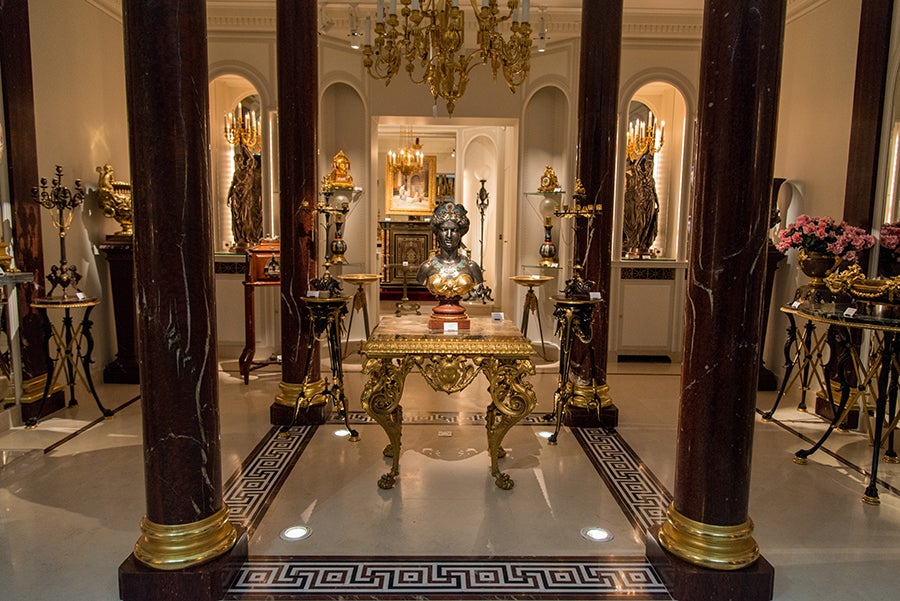
About the Seller
4.9
Vetted Seller
These experienced sellers undergo a comprehensive evaluation by our team of in-house experts.
Established in 1997
1stDibs seller since 2018
74 sales on 1stDibs
Typical response time: <1 hour
Associations
International Confederation of Art and Antique Dealers' Associations
- ShippingRetrieving quote...Ships From: PARIS, France
- Return PolicyA return for this item may be initiated within 7 days of delivery.
More From This SellerView All
- Pair of Louis XV Style Vitrines Attributed to J.-E. Zwiener, France, Circa 1885By Joseph-Emmanuel ZwienerLocated in PARIS, FRRare pair of Louis XV style gilt-bronze mounted curved shape vitrines attributed to J.E Zwiener. Glazed on all sides, they open with two doors framed by gilded and chiseled Rocaille style foliated bronze mounts. Resting on four cabriole legs ending with lion’s paws, the whole is covered by a « brèche de Benou » marble top. This model was probably designed by L. Messagé. Joseph-Emmanuel Zwiener was born in Germany in 1849. In 1880 he sets up his extensive workshops in rue de la Roquette in Paris where he creates many original pieces of furniture. He imitated practically every style, ranging from ‘’Boulle’’ to Louis XVI and including extraordinary personal interpretations of the Louis XV ‘’exuberant’’ style. He participated in the 1889 Universal Exhibition, held in Paris, and was awarded the gold medal for his remarkable copy of that most famous piece of furniture, Louis XV’s desk. The catalogue of the exhibition included a wonderful elegy qualifying the work as perfect : « No criticism what-so-ever could be made ». As that other famous cabinet-maker François Linke, Zwiener had most of his bronzes modelled by Léon Messagé whose work was considered as being of the best possible quality. Léon Messagé is a renowned designer and sculptor who integrated in his ornaments related to the Rocaille asymmetry, new lines and shapes announcing the “Art Nouveau” style. But even though, Messagé found inspiration with these 18th century artists, such as Nicolas Pineau or J. A. Meissonier, he didn’t simply copy their work and showed great originality, even extravagance, with some designs contained in "Cahier des dessins et croquis style Louis XV". He realized numerous sketches on grey paper before the execution of a reduced or life sized model of his ornaments, made of wax or terra-cotta. From 1885, Léon Messagé started working with important Parisian cabinet...Category
Antique 1880s French Louis XV Vitrines
MaterialsMarble, Bronze
- Louis XV Style Table Attributed to J.E. Zwiener, France, circa 1880By Joseph-Emmanuel ZwienerLocated in PARIS, FRCharming veneered wood and gilded bronze Louis XV style table attributed to J.E. Zwiener, with an elegant "bois de bout" floral marquetry on the serpentine tray and on the two drawer...Category
Antique 1880s French Louis XV Tables
MaterialsBronze
- Rare Rock Crystal Chandelier Attributed to L. Messagé, France, circa 1890Located in PARIS, FRExceptional ormolu and rock crystal twenty-four-light chandelier attributed to L. Messagé. Made of cage form, the central stem cast with bulrush and a fruit-filled vase, issuing twen...Category
Antique 1890s French Louis XV Chandeliers and Pendants
MaterialsRock Crystal, Bronze
- "Japonisme" Vitrine Attributed to A. Giroux, France, Circa 1880By Maison GirouxLocated in PARIS, FRRare aesthetic movement showcase, opening in its upper part by two beveled glass doors framed by brass moldings, in its lower part by two door panels in carved walnut decorated with blooming branches and gilded bronze ornaments representing dragons and birds. The sides are carved, like wicker woven. This showcase is topped by an important carved and gilded walnut cornice depicting a Fô Dog in its center, with a protective power, and rests on elephant head with overtuned trunk shaped feet. This type of elephant head with overtuned trunk shaped feet is a characteristic of the Maison Giroux, which can be found on many objects they produced. Aesthetic movement cabinet, signed Maison Alphonse Giroux...Category
Antique 1880s French Japonisme Vitrines
MaterialsBronze
- Pair of Neo-Renaissance Vitrines, Attributed to H-A Fourdinois, France, c. 1860Located in PARIS, FRFine pair of neo-Renaissance vitrines in richly carved wood, with three glazed sides framed by a relief frieze. Each opening to a drawer decorated with interlacing on the belt, and t...Category
Antique 1860s French Renaissance Revival Vitrines
MaterialsMarble
- Crystal & Bronze Display Case Attr. to l'Escalier de Cristal, France, Circa 1880By L'Escalier de CristalLocated in PARIS, FRImportant display case attributed to l'Escalier de Cristal, made in engraved gilded bronze, with bent and beveled glazed panels and mirror background plaques. The top and the sides can be completely and widely opened. L’Escalier de Cristal, Parisian firm created circa 1800 by Mme veuve Desarnaud, famous under the French “Restoration” for its decorative objects combining crystal and bronze. She was awarded a gold medal at the 1819 Paris Exposition des Produits de l’Industrie for an outstanding gilt-bronze mounted crystal dressing table. Located in Paris, at the Palais-Royal, Galerie de Valois, L’Escalier de Cristal was bought out circa 1830 by Boin, and then by Lahoche in 1840. The company owed its rise to a position amongst the most important Paris decorative wares shops to Lahoche, who expanded considerably the business and entered later in partnership with his son-in-law to set up in 1852 Lahoche et...Category
Antique 1880s French Vitrines
MaterialsCrystal, Bronze
You May Also Like
- Rare Matched Pair of Louis XVI Style Wall Vitrines by Zwiener, circa 1890By Joseph-Emmanuel ZwienerLocated in Brighton, West SussexA rare and unusual matched pair of Louis XVI style gilt bronze-mounted wall vitrines by Joseph-Emmanuel Zwiener. French, circa 1890. Signed ‘E. Zwiener’ to the base of the bro...Category
Antique Late 19th Century French Louis XVI Vitrines
MaterialsBronze
- Pair of Louis XVI Style Vitrines with Wedgwood Plaques by Zwiener, circa 1880By Joseph-Emmanuel ZwienerLocated in Brighton, West SussexAn important pair of Louis XVI style gilt-bronze mounted vitrines with wedgwood Jasperware plaques, by Joseph-Emmanuel Zwiener. French, circa 1880. Stamped 'NZ', 'NZ.309' and 'ZJ' to the reverse of the bronze mounts. Signed to the reverse of the lockplate 'Mon THEAU THIEFFINE Succ./SERRURIER PARIS'. This rare pair of vitrines, each have a shaped Carrera marble top above a frieze centred by a round classical Jasperware plaque flanked by gilt-bronze putti figures and scrolling acanthus running pattern. Below is a gilt-bronze framed bevelled glass door above a panel centred by a finely modelled Jasperware plaque of a putto representing the seasons. The door is flanked to either side by gilt-bronze monnaie pattern and headed by a pair of exceptionally fine female canephor figures. The shaped sides have corresponding bevelled glass panels and the vitrine is raised on tapering fluted legs. The distinctive canephor figures, finely cast as female caryatids with ringlets in their hair and supporting baskets of fruit upon their heads, is a distinctive and celebrated model unique to Zwiener. Many of Zwieners bronzes are executed in the Louis XV style, with flowers and scrolling acanthus leaves and an emphasis on asymmetry, typical of the work of his bronze sculptor Léon Messagé. The mounts employed on this rare pair of vitrines however sees Zwiener creating his own up-to-date reinterpretation of the Louis XVI style, drawing inspiration from established Louis XVI models such as those designed by Weisweiler for Marie-Antoinette's Dressing table. [See Mestdagh, p.305]. A second distinctive feature of the vitrines is the finely modelled Wedgwood Jasperware plaques incorporated in the frieze of each vitrine and beneath the doors. Wedgwood exhibited at nearly all of the Universal Exhibitions held in 19th century France, displaying amongst other pieces, plaques specifically intended to be mounted on to furniture. The first vitrine displays to the frieze a finely modelled plaque in the classical style, depicting a group of putti at play, one being pushed on a swing, while another plays a trumpet and a small attentive dog watches from below. Beneath the glass panelled door a larger Jasperware plaque is incorporated depicting a putto figure with a garland of flowers, emblematic of spring. The second vitrine has a classical plaque...Category
Antique Late 19th Century French Louis XVI Vitrines
MaterialsBronze
- Wonderful 19th Century Gilt Bronze Mounted Vitrine by Joseph ZwienerBy Joseph-Emmanuel ZwienerLocated in New York, NYA wonderful late 19th century Louis XV style gilt bronze mounted vitrine by Joseph Zwiener. Joseph Zwiener The serpentine-shaped brèche d’ alep marble top above a single centered glass door, flanked to each side by a conforming panel, the mirrored interior fitted with three adjustable glass shelves, the canted angles set with pierced foliate-cast clasps, above a bombé shaped apron, on cabriole legs with scrolled-acanthus sabots. The quality of the cabinetry and solid wood frame, along with the quality and design of the mounts, is characteristic of Zwiener’s oeuvre. Similar flower-filled cornucopia chutes can be found on other Zwiener models. Born in Herdon, Germany, in 1849, Joseph Emmanuel Zwiener followed the tradition of some of the best ébnistes of the nineteenth century. He moved to Paris establishing a workshop at 12, rue de la Roquette, between 1880 and 1895. He produced a wide array of the very finest furniture, modelling in his own interpretations of the eighteenth century Louis XV Rococo style, veneered with the highest and finest quality marquetry and ‘Vernis Martin’ panels. Exhibiting at the Exposition Universelle, Paris, in 1889, Zwiener was awarded a gold medal for what the jury reported as ‘dè ses dèbuts à une Exposition Universelle, [il] s’est mi au premier rang par la richesse, la hardinesse, et le fini de ses meubles incrustés de bronze et fort habilment marquetés.’ Zwiener was closely associated with François Linke, and the two houses produced work which, at first glance, is remarkably similar and with occasionally identical mounts. The similarities are made more likely by the fact that the brilliant sculptor, Léon Messagé, worked initially for Zwiener and subsequently, upon Zwiener’s departure for Berlin to work on furniture commissioned by Freidrich Wilhelm II , he was employed in the workshop of François Linke. It appears that Zwiener, unlike Linke, did not sign all his work, although some stamped pieces with his name and/or his “Z” initial are documented. There is some uncertainty between the recorded stamp E. Zwiener and the work of a Julius Zwiener...Category
Antique Late 19th Century French Belle Époque Cabinets
MaterialsMarble, Bronze
- Wonderful 19th Century Gilt Bronze Mounted Vitrine Table by Joseph ZwienerBy Joseph-Emmanuel ZwienerLocated in New York, NYA wonderful late 19th century gilt bronze Mounted Louis XV style Vitrine table by Joseph Zwiener Joseph Zwiener The oval shaped table with a beveled glass top encircled by a bronze frieze, above four side glass panels, the canted angles set with pierced foliate-cast clasps, standing on cabriole legs tapering to scrolled sabots. Born in Herdon, Germany, in 1849, Joseph Emmanuel Zwiener followed the tradition of some of the best ébnistes of the nineteenth century. He moved to Paris establishing a workshop at 12, rue de la Roquette, between 1880 and 1895. He produced a wide array of the very finest furniture, modeling in his own interpretations of the eighteenth century Louis XV Rococo style, veneered with the highest and finest quality marquetry and ‘Vernis Martin’ panels. Exhibiting at the Exposition Universelle, Paris, in 1889, Zwiener was awarded a gold medal for what the jury reported as ‘dè ses dèbuts à une Exposition Universelle, [il] s’est mi au premier rang par la richesse, la hardinesse, et le fini de ses meubles incrustés de bronze et fort habilment marquetés.’ Zwiener was closely associated with François Linke, and the two houses produced work which, at first glance, is remarkably similar and with occasionally identical mounts. The similarities are made more likely by the fact that the brilliant sculptor, Léon Messagé, worked initially for Zwiener and subsequently, upon Zwiener’s departure for Berlin to work on furniture commissioned by Freidrich Wilhelm II , he was employed in the workshop of François Linke. It appears that Zwiener, unlike Linke, did not sign all his work, although some stamped pieces with his name and/or his “Z” initial are documented. There is some uncertainty between the recorded stamp E. Zwiener and the work of a Julius Zwiener...Category
Antique Late 19th Century French Belle Époque Vitrines
MaterialsBronze
- Beautiful French Kingwood Vitrine, circa 1890By Henry DassonLocated in Lincoln, GBA beautiful French Kingwood Vitrine circa 1890 of exceptional colour and quality with gilt bronze mountings and two shaped glass shelves, glass panels to the side and one door to the...Category
Antique 19th Century French Vitrines
MaterialsMarble, Bronze
- French Louis XV Style Ormolu and Vernis Martin Vitrine Attributed to F. LinkeBy François LinkeLocated in Los Angeles, CAA very fine French 19th century Louis XV style ormolu mounted plum pudding mahogany veneer, mahogany and Vernis Martin decorated vitrine à Deux Corps, probably by François Linke (1855-1946). The lower structure fitted with finely chased gilt-bronze mounts with female masks, musical instruments, floral drapes, bows and acanthus, centred with a frieze drawer and a cupboard door with three painted panels. The centre front painted panel with a Romantic courting park setting scene amongst sheep and a sculpture fountain of Putti; the side panels both with parks scenes of a resting lion sculpture and fountain flanked by grassing sheep. The lower cabinet interior with three drawers, the upper vitrine case with two glass shelves, a bowed beveled front door and sides, crowned with a fine gilt-bronze wreath mount with ribbons, all raised on four cabriolet legs with cast lion paw mounts. Unsigned, Paris, circa 1890-1900. The style of this cabinet is closely related to those produced in the Paris furniture making trade in the Faubourg Saint-Antoine in the 1880s and as such, without a signature or identifying mark, is unattributable. However, there are similarities with the firm Raoux et Brunet, some of whose mounts were designed by Léon Messagé and later used by François Linke. Indeed many of the mounts on this cabinet, whilst not exclusive to him, are very similar to the work produced in his early years in Paris in the 1880s. At this time Linke was making furniture to order...Category
Antique Late 19th Century French Louis XV Vitrines
MaterialsOrmolu, Bronze
Recently Viewed
View AllMore Ways To Browse
French E
Antique Paper Cabinet
Parisian Cabinet
Glass Door 1890
Best French Doors
Leon Wood
18th Century French Inlay Cabinet
Gold Gilded Cabinet
Message Bronze
Lion Paw Cabinet
Antique Marble Paper
1900 Wood And Glass Case
Joseph E
Vitrine New
Antique Glass Cut To Size
Cabinet With Lion Paw Feet
Glass Gold Gilted Cabinet
French Louis Xv Vitrine
